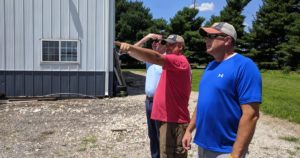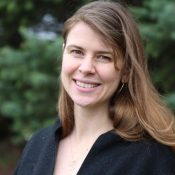One May in the 1980s, a dust bowl came through Logan County 30 miles northeast of Springfield. The Martin Farm near Mount Pulaski, Illinois had just tilled wheat acres to plant corn when the brothers saw the front of the storm hit their fields. It was then that Jeff and Tom Martin realized something about the way they farmed wasn’t right. It took some thought, but they were committed to figuring out what they had to do to never let something like this happen again. This was when they started looking into conservation farming practices.
 Jeff and Tom started by reducing their tillage. Reduced tillage improves soil health by not continually destroying the improved soil structure that soil organisms are trying to create. The first year they limited their experiment to only 20 acres. When their dad came out to see what they were up to, he didn’t say a thing. He just turned around and drove back to the house. He didn’t tell them to stop, but they knew he wasn’t comfortable trying out new farming methods. It turned out that those 20 acres produced their best corn crop that year.
Jeff and Tom started by reducing their tillage. Reduced tillage improves soil health by not continually destroying the improved soil structure that soil organisms are trying to create. The first year they limited their experiment to only 20 acres. When their dad came out to see what they were up to, he didn’t say a thing. He just turned around and drove back to the house. He didn’t tell them to stop, but they knew he wasn’t comfortable trying out new farming methods. It turned out that those 20 acres produced their best corn crop that year.
It took 15 years of trial and error to figure out how to make no-till work back then, and change hasn’t always gone smoothly for the Martin Farm. When switching to conservation practices, Jeff says, you have to be willing to go over speed bumps to figure out how to get past them. “A lot of people converted to no-till and then experienced a wet spring, and now they’re gone,” he said. Today, Jeff finds the technology available makes it much more doable.
It is farming pioneers like Jeff that create an incentive for farm equipment companies to invest in developing new technology for farming in more conservation minded ways.
Returning to the farm and taking the next step in soil health
When Jeff Martin’s sons, Doug and then Derek, joined the farm full time in 2011 and 2013, they began adding cover crops and microbial solutions into the mix. It now takes them about three to four years to start seeing changes in soil health and yield. “The soil didn’t get ruined in a year,” Derek figures, “so it will take more than a year to fix it.”

Doug and Jeff started doing cover crops through a program with their local Soil and Water Conservation Program. Steve Bracey, their local Resource Conservationist, enrolled them in the USDA Conservation Stewardship Program which provides cost-share for farmers transitioning to conservation cropping systems. Then they got into directly adding beneficial microbes back into the soil to speed the process up. Together they have seen a dramatic increase in their soil health. The Martins started with 40 acres of cover crops, and now they have over 3,000 acres converted. Jeff says, “I’ve had more fun in my last 3 years than in my whole 45 years of farming.”
For example, they have one 40-acre field that was always one of their worst fields because it was so wet. There’s even a wetland in the middle of it that they enrolled in the Conservation Reserve Program (CRP). CRP is also known to many farmers as the “set aside program.” It pays farmers to set aside farmland for wildlife habitat and water quality projects. Now after four years under their new program of no-till, cover crops, and added microbes, it’s one of the Martin’s best yielding fields. In fact, for the past two years it has out produced a pattern tiled field less than a quarter a mile a way. By improving the soil’s health, they have improved its structure, which helps it absorb more water when it’s wet, but also hold more water now when we’re having longer dry spells.
A common question farmers ask about no-till farming is does it pay. With no-till the cost savings are very straightforward: there are reduced passes across the field and reduced fuel costs.

Cover crops are more complex. In the beginning, Doug says, they didn’t spend less money, they just spent it differently. “We try to spend it better.” Often times, they left a few bushels on the table, but they were more profitable because they got a higher rate of return for their inputs. Now that their soil is really coming alive, they are able to make dramatic reductions in their fertilizer and pesticide use, another cost saver, and maintain high yields. They’ve cut back on a lot of their phosphorus and potassium and almost a third of their nitrogen. Doug sees farmers falling off the ledge every day with high input costs and low crop markets. The Martin Farm is trying to do better.
They invested in their soil’s health to protect our water and their bottom line.
As Derek views it, “we’re only renting the land from the next generation.” It’s their job to leave the soil better than when they got it.
 Catie Gregg coordinates our campaigns to expand the adoption of conservation cropping systems in Illinois.
Catie Gregg coordinates our campaigns to expand the adoption of conservation cropping systems in Illinois.







